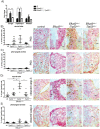Craniofacial Defects in Embryos with Homozygous Deletion of Eftud2 in Their Neural Crest Cells Are Not Rescued by Trp53 Deletion
- PMID: 36012294
- PMCID: PMC9409426
- DOI: 10.3390/ijms23169033
Craniofacial Defects in Embryos with Homozygous Deletion of Eftud2 in Their Neural Crest Cells Are Not Rescued by Trp53 Deletion
Abstract
Embryos with homozygous mutation of Eftud2 in their neural crest cells (Eftud2ncc-/-) have brain and craniofacial malformations, hyperactivation of the P53-pathway and die before birth. Treatment of Eftud2ncc-/- embryos with pifithrin-α, a P53-inhibitor, partly improved brain and craniofacial development. To uncover if craniofacial malformations and death were indeed due to P53 hyperactivation we generated embryos with homozygous loss of function mutations in both Eftud2 and Trp53 in the neural crest cells. We evaluated the molecular mechanism underlying craniofacial development in pifithrin-α-treated embryos and in Eftud2; Trp53 double homozygous (Eftud2ncc-/-; Trp53ncc-/-) mutant embryos. Eftud2ncc-/- embryos that were treated with pifithrin-α or homozygous mutant for Trp53 in their neural crest cells showed reduced apoptosis in their neural tube and reduced P53-target activity. Furthermore, although the number of SOX10 positive cranial neural crest cells was increased in embryonic day (E) 9.0 Eftud2ncc-/-; Trp53ncc-/- embryos compared to Eftud2ncc-/- mutants, brain and craniofacial development, and survival were not improved in double mutant embryos. Furthermore, mis-splicing of both P53-regulated transcripts, Mdm2 and Foxm1, and a P53-independent transcript, Synj2bp, was increased in the head of Eftud2ncc-/-; Trp53ncc-/- embryos. While levels of Zmat3, a P53- regulated splicing factor, was similar to those of wild-type. Altogether, our data indicate that both P53-regulated and P53-independent pathways contribute to craniofacial malformations and death of Eftud2ncc-/- embryos.
Keywords: Eftud2; MFDM; P53; craniofacial; neural crest cells; neurocristopathies; spliceosomopathies; splicing.
Conflict of interest statement
The authors declare no competing interest.
Figures






References
-
- Huang D.W., Sherman B.T., Tan Q., Collins J.R., Alvord W.G., Roayaei J., Stephens R., Baseler M.W., Lane H.C., Lempicki R.A. The DAVID Gene Functional Classification Tool: A novel biological module-centric algorithm to functionally analyze large gene lists. Genome Biol. 2007;8:R183. doi: 10.1186/gb-2007-8-9-r183. - DOI - PMC - PubMed
-
- Beauchamp M.C., Djedid A., Daupin K., Clokie K., Kumar S., Majewski J., Jerome-Majewska L.A. Loss of function mutation of Eftud2, the gene responsible for mandibulofacial dysostosis with microcephaly (MFDM), leads to pre-implantation arrest in mouse. PLoS ONE. 2019;14:e0219280. doi: 10.1371/journal.pone.0219280. - DOI - PMC - PubMed
-
- Beauchamp M.C., Djedid A., Bareke E., Merkuri F., Aber R., Tam A.S., Lines M.A., Boycott K.M., Stirling P.C., Fish J.L., et al. Mutation in Eftud2 causes craniofacial defects in mice via mis-splicing of Mdm2 and increased P53. Hum. Mol. Genet. 2021;30:739–757. doi: 10.1093/hmg/ddab051. - DOI - PMC - PubMed
MeSH terms
Substances
Grants and funding
LinkOut - more resources
Full Text Sources
Medical
Molecular Biology Databases
Research Materials
Miscellaneous

